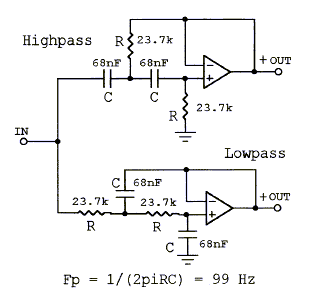Question...do Metallized Polypropylene caps have a + and - side?
How about Metal Oxide resistors?
One final one....if there is a +/-, does the - side go to the amp and the + go to the speaker?
Thanks in advance for your help and knowledge, I feel a little stupid asking a question like this, but I figure that it is better to ask then it is to destroy stuff for no reason!!
How about Metal Oxide resistors?
One final one....if there is a +/-, does the - side go to the amp and the + go to the speaker?
Thanks in advance for your help and knowledge, I feel a little stupid asking a question like this, but I figure that it is better to ask then it is to destroy stuff for no reason!!
Thanks for the reply! I really appreciate the comment about doing research, I really believe that to gain a true understanding that you need to fully appreciate this hobby you need a solid foundation of the mathematics behind the scenes. I am pretty comfortable with the theory, I have a mechanical engineering background, but the practical aspect of this endeavor into speakers has me a little out of my league. I am fairly comfortable soldering, but some of the relatively simple things elude me from lack of exposure/experience.
I have been reading and researching on the net for about the past two or three months before I started to play around my my current speakers. I have three identical speakers, I am systematically making mods to each to determine what changes have what effect on the sound and comparing them one to another. I am very curious as to how the crossover mod will change the sound.
I have been reading and researching on the net for about the past two or three months before I started to play around my my current speakers. I have three identical speakers, I am systematically making mods to each to determine what changes have what effect on the sound and comparing them one to another. I am very curious as to how the crossover mod will change the sound.
Intrinsicallically, a film capacitor is symmetrical to what is applied to it.
In a normal, sensible world, all capacitors would be the same, and you would be able to fit them any which way you wanted.
The rat in the ointment is electrolytics, which behave, and are created to behave, quite unusually. This is due to the "dielectric" material being a manufacured oxide layer which exists only on the anode and not the cathode.
So basically, unless it's an electolytic, you can do what you want.
(Except if it's a bipolar electrolytic, in which case............
In a normal, sensible world, all capacitors would be the same, and you would be able to fit them any which way you wanted.
The rat in the ointment is electrolytics, which behave, and are created to behave, quite unusually. This is due to the "dielectric" material being a manufacured oxide layer which exists only on the anode and not the cathode.
So basically, unless it's an electolytic, you can do what you want.
(Except if it's a bipolar electrolytic, in which case............
Do not put away your soldering iron.
But DO the research as well.
Just be careful when turning it on for the first time. Always use a fuse on the AC power cord.
What I used to do, is place a glass bowl over the circuit, fire it up, and if you've done your research...there won't actually be any fire.
=R=
But DO the research as well.
Just be careful when turning it on for the first time. Always use a fuse on the AC power cord.
What I used to do, is place a glass bowl over the circuit, fire it up, and if you've done your research...there won't actually be any fire.
=R=
MCampbell said:So basically, unless it's an electolytic, you can do what you want.
(Except if it's a bipolar electrolytic, in which case............
Don't forget tantalum capacitors, they too have a polarity that needs to be observed. Note the difference in markings: on electrolytics it's usually the minus that's marked, on tantalums the plus.
Funny thing is I've come across incorrectly placed tantalums that worked for a while before they blew. Some blow straight away, others survive many hours!
A colleague always warns us when he starts testing boards with a lot of SMD tantalum capacitors. Why? Since RoHS there are some that blow spontaneously at first power up, depsite being placed correctly and NOT being overvolted!
A colleague always warns us when he starts testing boards with a lot of SMD tantalum capacitors. Why? Since RoHS there are some that blow spontaneously at first power up, depsite being placed correctly and NOT being overvolted!
Sounds like an interesting topic of investigation - both the reversed tants working, and the RoHS impact.
Only big RoHS-related failure problem I've had to deal with is tin whiskers. Can cause havoc iif you find one of these in your electrical circuit (see photo).
Only big RoHS-related failure problem I've had to deal with is tin whiskers. Can cause havoc iif you find one of these in your electrical circuit (see photo).
Attachments
MCampbell said:Only big RoHS-related failure problem I've had to deal with is tin whiskers.
Whiskas is definitely polarity sensitive and directional....always in one hole, out the other.
=RR=
Get a second opinion on this, but I'm pretty sure film caps have been marked, not for polarity, but for physical construction. Those yellow CDE Mylar caps come to mind- the ones with a big black bar on one end. One lead will be tied to the outside foil, which can act as a shield, and in some applications the way you install it may affect noise pickup. IMO, for audio it shouldn't matter- the caps will be large enough to look like a short circuit at audio frequencies, so the signal will be pretty much identical on both sides. Any noise will also appear on both sides, regardless of where it came from.
Conrad Hoffman said:.... Those yellow CDE Mylar caps come to mind- the ones with a big black bar on one end. One lead will be tied to the outside foil, which can act as a shield, and in some applications the way you install it may affect noise pickup. ......
As are most polystyrene caps.
I've read the "marked end" is best placed at (toward) a circuit "node".
My knowledge of what a "node" really is...is limited.
Any suggestions ?
For example, in an active filter circuit ? :

© 1999-2007 LINKWITZ LAB, All Rights Reserved
=RR=
Redrabbit, a perfect example. Any common connection between components is a node. The junction of the two caps and a resistor on top is a node. Now, let's say the thing driving the whole circuit has zero output impedance. The node between the caps and resistor has higher impedance, though you'd have to calculate exactly what, at the frequency of interest.
The question (in my mind anyway) is, do you install the first cap with the outside foil connected to the input- where the low impedance of the driving circuit will prevent any noise pickup, but it could also radiate everywhere if the cap is physically large, or do you install it the other way where the noise pickup could be greater, but the signal level is likely smaller and radiation less. Or, does it matter not one whit?
The question (in my mind anyway) is, do you install the first cap with the outside foil connected to the input- where the low impedance of the driving circuit will prevent any noise pickup, but it could also radiate everywhere if the cap is physically large, or do you install it the other way where the noise pickup could be greater, but the signal level is likely smaller and radiation less. Or, does it matter not one whit?
- Status
- This old topic is closed. If you want to reopen this topic, contact a moderator using the "Report Post" button.
- Home
- Design & Build
- Parts
- Newbie Question about caps....
